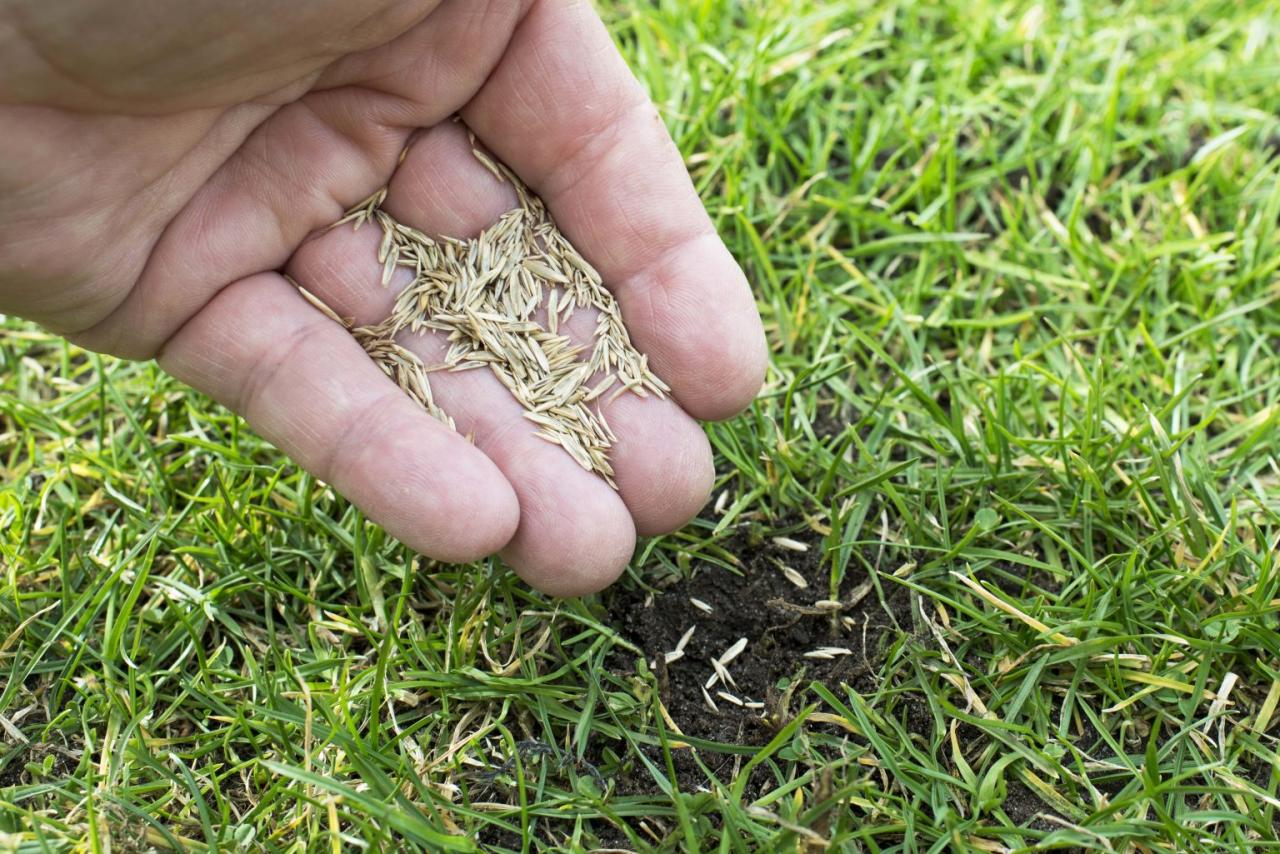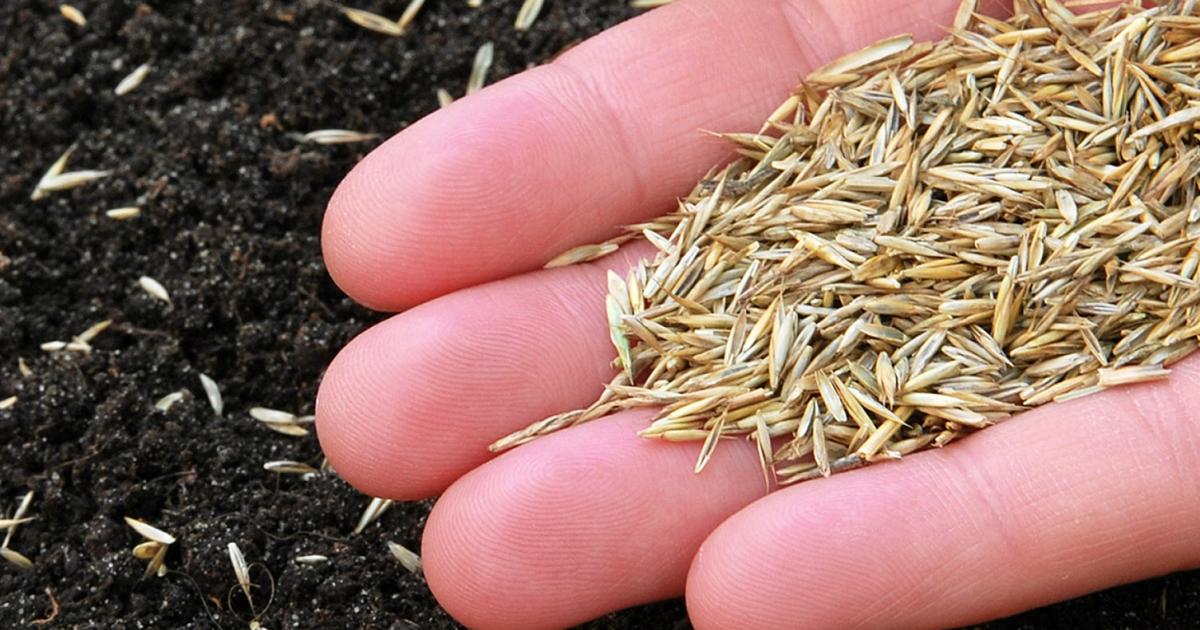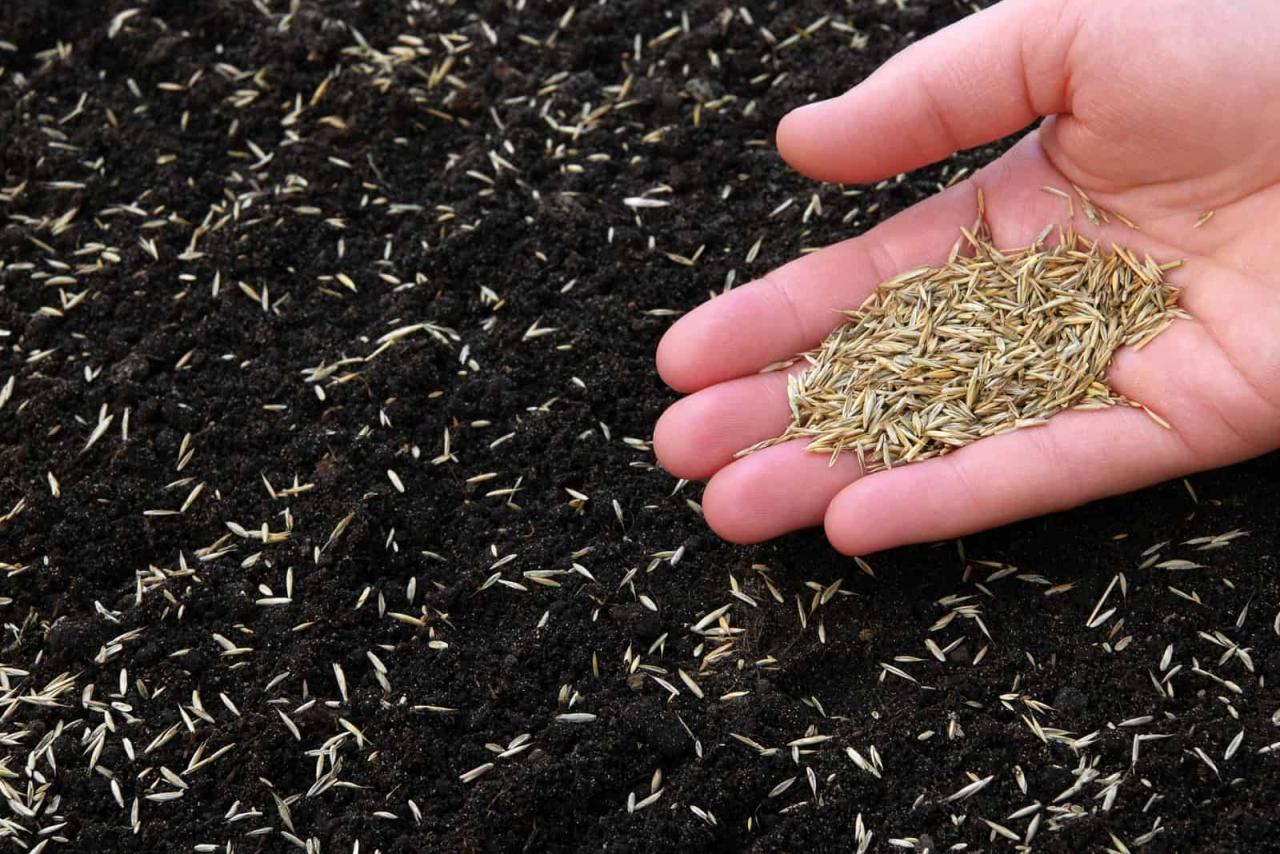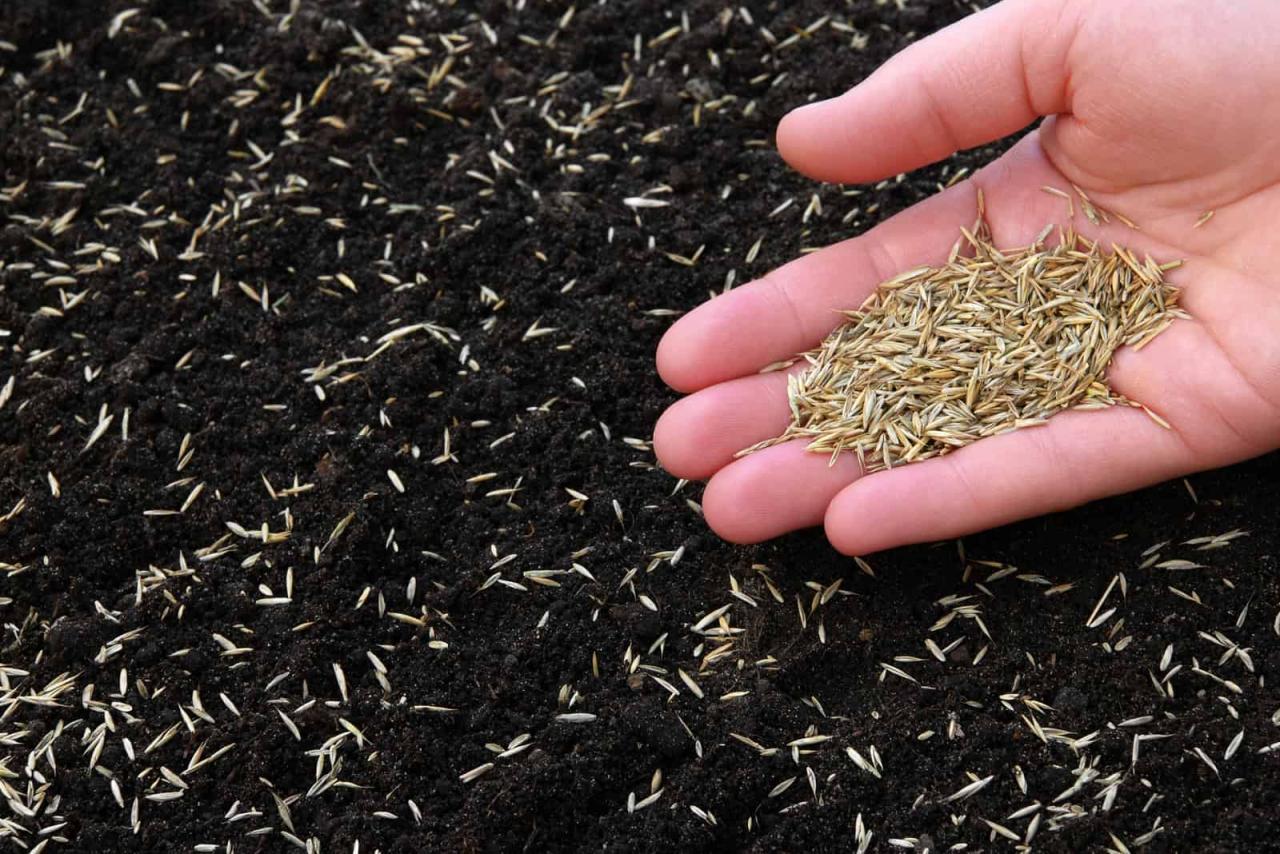The Best Timing for Grass Seed Sowing: How to Achieve a Lush and Healthy Lawn, is the key to a thriving green space. Whether you’re starting a new lawn or simply overseeding existing areas, understanding the optimal sowing periods for your region is crucial.
Timing influences germination, establishment, and ultimately, the health and longevity of your lawn. By carefully considering factors like temperature, rainfall, and soil conditions, you can create the ideal environment for your grass seeds to flourish.
This guide will delve into the importance of timing, providing a detailed breakdown of the best sowing seasons for various regions and climates. We’ll explore essential soil preparation techniques, compare different sowing methods, and offer valuable tips for post-sowing care.
By following these guidelines, you’ll be well on your way to achieving a lush, healthy lawn that you can enjoy for years to come.
Understanding the Importance of Timing

Timing is crucial for successful grass seed sowing. Sowing at the right time maximizes germination rates, promotes strong root development, and enhances the overall health and resilience of your lawn.
Optimal Timing for Germination and Establishment
The ideal time for sowing grass seed is when the soil temperature is consistently within the optimal range for germination and root development. This varies depending on the grass type and your location’s climate. Generally, cool-season grasses thrive in cooler temperatures, while warm-season grasses prefer warmer conditions.
- Cool-season grasses:These grasses germinate best in temperatures between 60°F and 75°F (15°C and 24°C). The ideal time to sow cool-season grasses is in early fall or late spring. This allows the seedlings to establish roots before the harsh winter or summer heat arrives.
- Warm-season grasses:These grasses germinate best in temperatures between 70°F and 85°F (21°C and 29°C). The best time to sow warm-season grasses is in late spring or early summer, when the soil has warmed up sufficiently.
Impact of Incorrect Sowing Times
Sowing grass seed at the wrong time can lead to various problems, affecting germination, establishment, and overall lawn health.
- Poor germination:If the soil temperature is too cold or too hot, grass seeds may not germinate or may germinate slowly, resulting in a patchy lawn.
- Weak seedlings:Seedlings that germinate in unfavorable conditions may be weak and susceptible to disease, pests, and competition from weeds.
- Delayed establishment:Seedlings may struggle to establish a strong root system in extreme temperatures, leading to a slow-growing and vulnerable lawn.
- Increased stress:Grass seedlings are more vulnerable to stress from drought, heat, and cold during the establishment phase. Sowing at the wrong time can exacerbate these stresses, leading to a less healthy lawn.
“Timing is everything when it comes to sowing grass seed. By understanding the optimal temperature ranges for your grass type, you can maximize your chances of success and create a lush, healthy lawn.”
Ideal Sowing Seasons

The ideal time to sow grass seed varies depending on your location and climate. Understanding the best sowing seasons for your region ensures optimal germination, establishment, and a healthy, lush lawn. This section delves into the factors influencing optimal sowing times and provides a comprehensive guide to ideal sowing periods for various geographic locations.
Factors Influencing Optimal Sowing Times
Several factors influence the best time to sow grass seed, ensuring successful germination and establishment:
- Temperature:Grass seeds require a specific temperature range for germination. Most cool-season grasses germinate best in temperatures between 60°F and 75°F (15°C and 24°C), while warm-season grasses prefer temperatures between 70°F and 85°F (21°C and 29°C).
- Rainfall:Adequate moisture is crucial for seed germination and root development. Sowing during periods with consistent rainfall or regular watering will promote healthy growth.
- Soil Conditions:The soil should be well-drained and have a suitable pH level for the chosen grass variety. Testing the soil pH and amending it if necessary will improve seed germination and growth.
- Sunlight:Most grass varieties require at least six hours of sunlight per day for optimal growth. Choose a sowing time that allows sufficient sunlight exposure for the new grass.
Ideal Sowing Periods for Various Geographic Locations, The Best Timing for Grass Seed Sowing: How to Achieve a Lush and Healthy Lawn
The table below Artikels the ideal sowing periods for different geographic locations, taking into account the factors discussed above. Remember to adjust these periods based on your specific microclimate and local weather patterns.
Location |
Ideal Sowing Period (Cool-Season Grasses) |
Ideal Sowing Period (Warm-Season Grasses) |
|---|---|---|
Northern United States |
Early Spring (March-May) or Early Fall (August-October) |
Late Spring (May-June) or Late Summer (August-September) |
Southern United States |
Late Fall (October-November) or Early Spring (February-March) |
Spring (March-May) or Summer (June-August) |
Canada |
Early Spring (April-May) or Late Summer (August-September) |
Not recommended due to short growing season |
Europe |
Early Spring (March-May) or Early Fall (August-September) |
Late Spring (May-June) or Summer (July-August) |
Australia |
Late Winter (July-August) or Early Spring (September-October) |
Late Spring (October-November) or Summer (December-February) |
Preparing the Soil for Success
Just as a strong foundation is crucial for a sturdy house, properly prepared soil is the cornerstone of a healthy and thriving lawn. The quality of your soil directly influences the growth and health of your grass, impacting its ability to absorb nutrients, water, and withstand stress.
Achieving a lush, healthy lawn starts with understanding the best time to sow grass seed. While the optimal timing varies depending on your region’s climate, cooler temperatures and consistent moisture often favor germination. If you’re looking to add a unique flavor to your dishes, consider incorporating perilla leaf, a versatile herb with a slightly minty and citrusy taste.
Elevate Your Cooking with Perilla Leaf: A Guide to Delicious and Fresh Meals provides a comprehensive guide to incorporating this flavorful ingredient into your culinary repertoire. Just as you’d nurture a new lawn with care, perilla leaf thrives with proper attention, ensuring a bountiful harvest for your culinary creations.
Preparing the Soil for Grass Seed Sowing
Before you start sowing your grass seed, it is essential to ensure that your soil is ready to provide the optimal environment for germination and growth. This involves a few key steps:
- Remove Existing Vegetation:If you are starting from scratch, clear the area of any existing grass, weeds, or debris. You can use a sod cutter or a sharp shovel to remove existing turf. For weeds, you may need to use a herbicide to ensure complete eradication.
- Loosen and Aerate the Soil:After removing existing vegetation, you need to loosen and aerate the soil to improve drainage and allow roots to penetrate deeper. You can achieve this by using a garden fork or a power tiller. Aerating the soil helps to break up compacted areas and improve air circulation, which is essential for root development.
- Level the Surface:Once the soil is loosened, use a rake to level the surface. A level surface ensures that the grass seed is evenly distributed and that water flows consistently.
Sowing Techniques for Optimal Results

The method you choose to sow your grass seed can significantly impact the success of your lawn. Choosing the right technique ensures even seed distribution, promotes germination, and helps establish a healthy, thick lawn. Let’s explore different sowing methods and their benefits.
Grass Seed Sowing Methods
Each sowing technique has its advantages and disadvantages, and the best choice depends on the size of your lawn, the type of grass seed, and your personal preferences.
- Broadcasting:This involves scattering the seed evenly over the prepared soil by hand. Broadcasting is simple and efficient for small areas.
- Overseeding:This method involves spreading seed over an existing lawn to thicken it or introduce a new type of grass. It’s a good option for filling in bare patches or improving the overall density of your lawn.
- Using a Seed Spreader:This mechanical method provides more precise and even seed distribution, especially for larger areas. Seed spreaders come in various sizes and types, with different settings for seed rate and spread width.
Advantages and Disadvantages of Each Method
The table below Artikels the pros and cons of each sowing technique, helping you choose the most suitable method for your lawn.
While you’re prepping your lawn for spring with the right timing for grass seed sowing, consider bringing the beauty of autumn indoors with some festive décor. For a touch of rustic charm, check out Add Warmth to Your Home with These Stunning Autumn Leaf Garland Ideas for inspiration.
Once your new grass starts to sprout, you’ll be ready to enjoy the outdoors with a beautiful, lush lawn.
Method |
Advantages |
Disadvantages |
|---|---|---|
Broadcasting |
Simple and inexpensive |
Can lead to uneven seed distribution, especially for larger areas |
Overseeding |
Improves existing lawn density and fills in bare patches |
May require multiple applications for optimal results, and seed may not germinate as easily in dense existing lawns |
Using a Seed Spreader |
Provides precise and even seed distribution, suitable for larger areas |
Requires a larger initial investment, and may not be ideal for small or irregularly shaped areas |
Visual Guide to Proper Sowing Techniques
- Broadcasting:Imagine scattering the seed like a fine rain over the prepared soil, ensuring even coverage across the entire area.
- Overseeding:Picture yourself walking across your existing lawn, gently spreading the seed in a back-and-forth motion, ensuring good seed distribution.
- Using a Seed Spreader:Envision yourself pushing a seed spreader across the lawn, adjusting the settings to achieve the desired seed rate and spread width for optimal results.
Post-Sowing Care for a Healthy Lawn
The initial weeks after sowing grass seed are crucial for establishing a healthy lawn. During this period, the delicate seedlings need consistent moisture and protection from environmental stressors to thrive. Proper post-sowing care will significantly influence the density, vigor, and overall success of your new lawn.
Watering for Seedling Growth
Watering is essential for seed germination and the initial growth of grass seedlings. Consistent moisture is crucial to ensure the seeds sprout and the roots develop properly. Overwatering can lead to root rot, while under-watering can cause the seedlings to dry out and die.
- Frequency:Water frequently, ideally twice a day during the first week after sowing. This will keep the soil consistently moist but not waterlogged. Reduce the frequency to once a day after the first week, and adjust based on weather conditions and soil type.
- Depth:Water deeply to encourage root growth. Aim for a watering depth of about 1 inch. You can use a rain gauge to measure the amount of water applied.
- Time of Day:Water early in the morning to minimize evaporation. Watering in the evening can create a humid environment, which can increase the risk of fungal diseases.
Preventing Weeds and Pests
Weeds and pests can quickly invade a newly established lawn, competing with the grass seedlings for resources. Taking preventative measures early on will help protect your new lawn and ensure its successful establishment.
- Pre-Emergent Herbicides:Applying a pre-emergent herbicide before sowing can help prevent weed seeds from germinating. These herbicides create a barrier in the soil, preventing weeds from sprouting.
- Hand-Weeding:Regularly hand-weed any weeds that do emerge. This is especially important during the early stages of lawn establishment, as weeds can quickly outcompete the grass seedlings.
- Pest Control:Monitor your lawn for signs of pests, such as grubs or insects. If you notice any infestation, take appropriate steps to control them. Consult a local nursery or lawn care professional for advice on suitable pest control methods.
Choosing the Right Grass Seed
Selecting the right grass seed is crucial for establishing a healthy and thriving lawn. It’s like choosing the right ingredients for a delicious meal – the right seed variety will ensure your lawn flourishes, while the wrong one could lead to disappointment.
Factors to Consider When Selecting Grass Seed
- Type of Grass:Different grass types have varying characteristics, such as growth habits, cold tolerance, and drought resistance. Understanding the types available in your region and their suitability for your specific needs is essential.
- Climate:Your local climate plays a significant role in determining the best grass type for your lawn. Consider factors like temperature extremes, rainfall patterns, and humidity.
- Shade Tolerance:If your lawn receives significant shade, choose grass varieties that can thrive in low-light conditions. Some grasses are more tolerant of shade than others.
- Foot Traffic:If your lawn experiences heavy foot traffic, select a durable grass type that can withstand wear and tear.
- Soil Type:The type of soil in your yard can influence the success of your grass. Some grasses are better suited to sandy soils, while others prefer clay.
Comparing and Contrasting Grass Seed Varieties
- Cool-Season Grasses:These grasses thrive in cooler temperatures and are typically best suited for regions with cold winters. They include Kentucky bluegrass, fine fescue, perennial ryegrass, and tall fescue.
- Warm-Season Grasses:These grasses prefer warmer temperatures and are ideal for regions with hot summers. Examples include Bermuda grass, zoysia grass, St. Augustine grass, and centipede grass.
Characteristics and Suitability of Different Grass Seed Varieties
Grass Type |
Characteristics |
Suitability |
|---|---|---|
Kentucky Bluegrass |
Dense, dark green blades; good wear tolerance; excellent for shady areas; slow to establish. |
Cool-season climates; high-traffic areas; shady lawns. |
Fine Fescue |
Fine-textured blades; drought tolerant; shade tolerant; slow to establish. |
Cool-season climates; shady lawns; low-maintenance areas. |
Perennial Ryegrass |
Fast-growing; good wear tolerance; excellent for overseeding; short-lived. |
Cool-season climates; temporary lawns; overseeding existing lawns. |
Tall Fescue |
Coarse-textured blades; drought tolerant; shade tolerant; good for low-maintenance lawns. |
Cool-season climates; low-maintenance lawns; shady areas. |
Bermuda Grass |
Fast-growing; aggressive; heat and drought tolerant; requires frequent mowing. |
Warm-season climates; sunny lawns; high-traffic areas. |
Zoysia Grass |
Fine-textured blades; dense growth; drought tolerant; slow to establish. |
Warm-season climates; low-maintenance lawns; sunny areas. |
St. Augustine Grass |
Coarse-textured blades; shade tolerant; good for coastal areas; susceptible to disease. |
Warm-season climates; shady lawns; coastal areas. |
Centipede Grass |
Fine-textured blades; low-maintenance; drought tolerant; slow-growing. |
Warm-season climates; low-maintenance lawns; acidic soils. |
Final Wrap-Up: The Best Timing For Grass Seed Sowing: How To Achieve A Lush And Healthy Lawn
Achieving a thriving lawn requires a strategic approach, and understanding the best timing for grass seed sowing is paramount. By carefully considering the ideal sowing seasons for your region, preparing the soil meticulously, selecting the right grass seed, and providing consistent post-sowing care, you’ll set the stage for a beautiful and healthy lawn.
Remember, patience is key during the establishment phase, as a little extra effort will go a long way in ensuring the success of your lawn in the long run.
FAQ Guide
What are the best months to sow grass seed in my region?
The best months for sowing grass seed vary depending on your specific region and climate. Consult local gardening resources or contact your local extension office for recommendations tailored to your area.
How long does it take for grass seed to germinate?
Germination time for grass seed can range from 7 to 21 days, depending on the type of grass, soil temperature, and moisture levels. Consistent watering and ideal soil conditions will help speed up the process.
How often should I water my new lawn?
Newly sown lawns require frequent watering, especially during the establishment phase. Aim for light but frequent watering, keeping the soil consistently moist but not waterlogged. The frequency and duration of watering will vary based on weather conditions.
What type of grass seed is best for my lawn?
The best type of grass seed for your lawn depends on factors like your climate, shade tolerance, and desired lawn appearance. Consider researching different grass varieties and their characteristics to make an informed decision.
